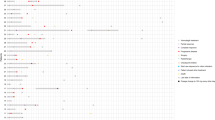Abstract
Basal cell carcinomas (BCCs) are the most frequent cancers in fair-skin adult patients. While most of them are accessible to medical or surgical treatment, some rare locally destructive forms (so called locally advanced BCC or someexceptionalmetastatic forms) cannot be treated by surgery or radiotherapy. Conventional chemotherapy (cisplatin, doxorubicine) is often difficult to perform as it is mostly palliative and not well tolerated in elderly patients. In 1996, the molecular pathway involved in BCC formation was identified: the patch/sonic/hedgehog pathway. Since then, major efforts have been performed to develop a targeted therapy to control the abnormal activation of the pathway. In 2009, results of the first phase I study were published using an anti-smo: the GDC-449 or vismodegib showing tolerability and anti-tumoral efficacy of this product. Response rates around 50% for both locally advanced and metastatic BCC have been obtained which were never achieved before. Since then several phase II studies have confirmed the efficacy of anti-smo molecules and extended their trial in the high risk for BCC Gorlin syndrome for multiple operable BCC. Long-termtolerability for these molecules is still not optimal andmust be improved. Targeted anti-smo molecule dramatically changes the strategy of care of patients with locally advanced ormetastatic BCC. In early 2012, vismodegib was approved by the FDA for the treatment of locally advanced or metastatic BCC.
Résumé
Les carcinomes basocellulaires (CBC) sont les cancers les plus fréquents chez l’adulte à peau claire. La plupart des CBC sont accessibles à un traitement médical ou chirurgical: traitement de référence. Les formes rares de CBC localement destructrices appelées CBC localement avancés (CBCla) ou les formes exceptionnelles de CBC métastatiques (CBCm) ne peuvent pas être traitées par chirurgie ou radiothérapie. L’utilisation d’une chimiothérapie conventionnelle (cisplatine, doxorubicine) n’a pas fait l’objet d’études validantes. Elle est volontiers mal tolérée par cette population de patients âgés, et n’a qu’un effet palliatif. Depuis 1996, la voie moléculaire impliquée dans la formation des CBC a été identifiée: il s’agit de la voie patch/sonic/hedgehog. Cette découverte a conduit en 2009 à la publication de la première étude de phase I utilisant un anti-smo, le GDC449 ou vismodegib. Cette étude a montré la tolérabilité et l’efficacité de ce produit. Des réponses thérapeutiques sont obtenues pour la première fois dans environ un cas sur deux pour les CBCla et les CBCm. Plusieurs études de phase II sont venues confirmer l’efficacité du vismodegib dans ces indications et pour des CBC opérables dans le cadre du syndrome de Gorlin caractérisé par la survenue précoce de très nombreux CBC. La tolérance du vismogenib à long terme n’est pas encore optimale et doit être améliorée. Les thérapies ciblées anti-smo révolutionnent la prise en charge des CBCla ou CBCm. Depuis début 2012, la FDA a approuvé l’utilisation du vismodegib pour la prise en charge des CBCla et des CBCm.
Similar content being viewed by others
Références
Ahnert JR, Baselga J, Tawbi HA, et al. (2010) A phase I dose escalation study of LDE225, a smothened (smo) antagonist, in patient with advanced solid tumors. Presented at the annual meeting of the American Society of Clinical Oncology Chicago, June 4–8. Abstract
Aplin AE, Kaplan FM, Shao Y (2011) Mechanisms of resistance to RAF inhibitors in melanoma. J Invest Dermatol 131 (9): 1817–1820
Bijlsma MF, Spek CA, Zivkovic D, et al. (2006) Repression of smoothened by patched-dependent (pro-)vitamin D3 secretion. PLoS Biol 4(8): e232
Dandurand M, Petit T, Martel P, et al. (2006) Management of basal-cell carcinoma in adults clinical practice guidelines. Eur J Dermatol 16(4): 394–401
Goldberg LH, Landau JM, Moody MN, et al. (2011) Resolution of odontogenic keratocysts of the jaw in basal-cell nevus syndrome with GDC-0449. Arch Dermatol 147(7): 839–841
Gould A, Missailidis S (2011) Targeting the hedgehog pathway: the development of cyclopamine and the development of anti-cancer drugs targeting the hedgehog pathway. Mini Rev Med Chem 11 (3): 200–213
Halna JM, Grandadam M, Bueni A (2000) Epidemiologic study of skin cancers from French population (1988–1996). Report of cancer registration of “Haut-Rhin” area. Nouv Dermatol 19(1): 48–55
Ingham PW (2012) Hedgehog signaling. Cold Spring Harb Perspect Biol 4(6) — doi: 10.1101/cshperspect.a011221
Metcalfe C, de Sauvage FJ (2011) Hedgehog fights back: mechanisms of acquired resistance against smoothened antagonists. Cancer Res 71(15): 5057–5061. Epub 2011 Jul 19. Review. Erratum in: Cancer Res 2011 Sep 15;71 (18): 6087
Miller DL, Weinstock MA (1994) Nonmelanoma skin cancer in the United States: incidence. J Am Acad Dermatol 30(5 Pt 1): 774–778
Rubin AI, Chen EH, Ratner D (2005) Basalcell carcinoma. N Engl J Med 353(21): 2262–2269
Rudin CM, Hann CL, Laterra J, et al. (2009) Treatmentof medulloblastoma with hedgehog pathway inhibitor GDC-0449. N Engl J Med 361(12): 1173–1178
Sekulic A, Migden MR, Oro AE, et al. (2012) Efficacy and safety of vismodegib in advanced basal-cell carcinoma. N Engl J Med 366(23): 2171–2179
Skvara H, Kalthoff F, Meingassner JG, et al. (2011) Topical treatment of basal-cel carcinomas in nevoid basal-cell carcinoma syndrome with a smoothened inhibitor. J Invest Dermatol 131(8): 1735–1744. doi: 10.1038/jid.2011.48.
Sterry W, European Dermatology Forum Guideline Committee (2006) Guidelines: the management of basal-cell carcinoma. Eur J Dermatol 16(5): 467–475
Tang JY, Mackay-Wiggan JM, Aszterbaum M, et al. (2012) Inhibiting the hedgehog pathway in patients with the basal-cell nevus syndrome. N Engl J Med 366(23): 2180–2188
Tang JY, Xiao TZ, Oda Y, et al. (2011) Vitamin D3 inhibits hedgehog signaling and proliferation in murine basal-cell carcinomas. Cancer Prev Res (Phila) 4(5): 744–751
Tang T, Tang JY, Li D, et al. (2011) Targeting superficial or nodular basal-cell carcinoma with topically formulated small molecule inhibitor of smoothened. Clin Cancer Res 17(10): 3378–3387
Telfer NR, Colver GB, et al. (2008) Guidelines for the management of basal-cell carcinoma. Br J Dermatol 159(1): 35–48
Von Hoff DD, LoRusso PM, Rudin CM, et al. (2009) Inhibition of the hedgehog pathway in advanced basal-cell carcinoma. N Engl J Med 361(12): 1164–1172
Author information
Authors and Affiliations
Corresponding author
About this article
Cite this article
Basset-Seguin, N. Thérapies ciblées et carcinomes basocellulaires. Oncologie 15, 101–105 (2013). https://doi.org/10.1007/s10269-013-2259-9
Received:
Accepted:
Published:
Issue Date:
DOI: https://doi.org/10.1007/s10269-013-2259-9




